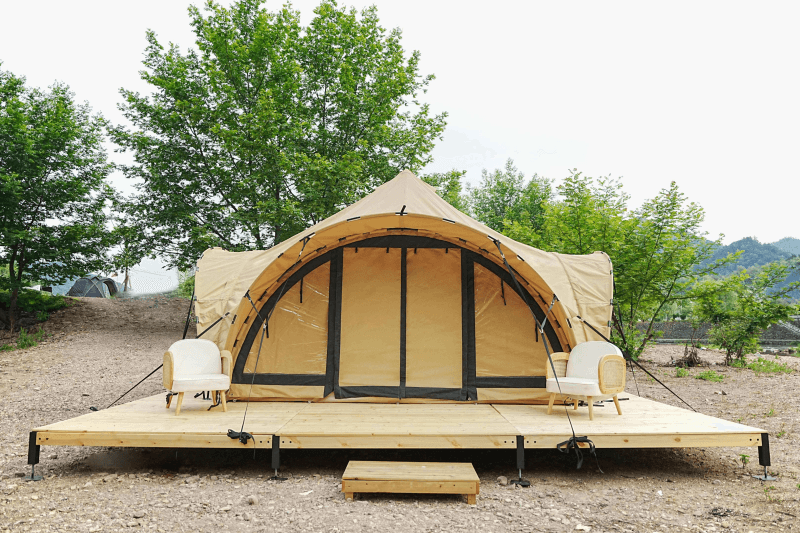Introduction to glamping yurt Materials
In the burgeoning world of glamping, yurts have carved out a niche thanks to their unique combination of comfort, style, and connection to nature. The materials used in constructing these yurts play a pivotal role in their appeal, providing both functional and aesthetic benefits. This article delves into the diverse materials chosen by top glamping yurt suppliers, focusing on their characteristics and benefits. Whether sourced from a wholesale factory or a specialist supplier, these materials are crafted to enhance the luxury camping experience.
Traditional Yurt Construction Materials
The traditional yurt design, inspired by centuries of Mongolian nomadic life, serves as a foundation for modern glamping structures. Essential materials like wood and felt continue to find their place in contemporary yurts, appreciated for their natural qualities and historic significance.
Wooden Frameworks
Wood is a staple in yurt construction, providing the necessary support and structure. Suppliers often choose timber such as spruce or pine due to its resilience and ease of handling. Modern innovations have introduced treated wood options that resist weathering, extending the lifespan of the yurt framework.
Felt Insulation
Felt, traditionally used for insulation, offers exceptional thermal properties. Suppliers who manufacture yurts at scale may treat felt with environmentally-friendly agents to enhance its durability without compromising its natural insulating capability.
Canvas: The Preferred Fabric for Durability
Canvas has become the go-to material for yurt exteriors, known for its durability and adaptability. Whether sourced from a factory or a local supplier, canvas materials are rigorously tested to ensure performance against the elements.
Cotton and Polycotton Blends
Cotton canvas is favored for its breathability and natural aesthetics, while polycotton blends offer added strength and moisture resistance. These fabrics are often utilized by suppliers aiming to balance traditional appeal with modern performance standards.
Weatherproof Treatments
- Water Resistance: Suppliers treat canvas with waterproof coatings to prevent moisture ingress.
- UV Protection: UV-resistant treatments are applied to reduce fabric degradation from sun exposure.
Insulation Techniques for Year-Round Comfort
To maintain a comfortable interior climate, glamping yurts deploy a variety of insulation materials and techniques.
Wool and Natural Fibers
Wool is another traditional insulation material, lauded for its warmth and sustainability. In modern yurts, wool insulation is often combined with other natural fibers, creating a composite that maximizes thermal efficiency and environmental friendliness.
Synthetic Insulation Options
For suppliers aiming to offer all-season yurts, synthetic insulation materials like polyester offer an effective barrier against extreme temperatures. These materials are particularly popular in factory-made yurts that need to adhere to stringent thermal performance criteria.
Structural Support: Wood vs. Steel
The choice of structural materials significantly influences the yurt’s stability and aesthetic. While wood remains popular, steel has emerged as a robust alternative in certain applications.
Comparative Analysis
- Wood: Offers warmth and a natural aesthetic, but requires treatment for long-term durability.
- Steel: Provides superior strength and weather resistance, ideal for larger yurts or those in extreme climates.
Flooring Options for Luxury Yurts
The flooring of a glamping yurt contributes both to its comfort and its stylish appeal. Various materials are favored by suppliers to meet different design and durability needs.
Wooden Floors
Engineered hardwood floors are a staple in luxury yurts, offering elegance and warmth. Wholesalers often provide pre-finished options that simplify installation while enhancing the floor’s resistance to wear.
Alternative Materials
Some suppliers opt for bamboo or composite materials, valued for their sustainability credentials and resistance to moisture. These materials often come from specialized factories dedicated to eco-friendly production.
Eco-Friendly Alternatives in Yurt Construction
Environmental considerations are increasingly influencing material choices in yurt construction. Suppliers are now prioritizing sustainable materials that reduce the carbon footprint of their products.
Recycled and Upcycled Materials
- Suppliers use recycled fabrics and metals to reduce waste.
- Upcycled wood offers a rustic look while conserving resources.
Sustainable Sourcing Practices
Factory processes are also under scrutiny, with many pursuing certifications that ensure responsible sourcing and minimal environmental impact.
Customization and Personalization of Yurts
Customization remains a key trend in the glamping industry, allowing yurt suppliers to cater to diverse consumer preferences.
Modular Components
Modular designs enable suppliers to offer yurts with customizable layouts and features, such as skylights or extended decking, often constructed in a factory to precise specifications.
Personal Design Choices
From bespoke color schemes to custom fittings, these personalized options add significant value, appealing to clients seeking unique and luxurious experiences.
Cost and Accessibility of Premium Yurt Materials
The cost of yurt materials typically reflects their quality and sourcing. While premium materials command higher prices, efficiency in production and wholesale distribution can make luxurious yurts more accessible.
Factory Efficiency
Advancements in factory efficiency have allowed suppliers to reduce production costs while maintaining high standards of quality, passing savings onto consumers without compromising on material excellence.
Wholesale Markets
Wholesale markets enable suppliers to source materials cost-effectively, ensuring that high-quality yurts remain competitively priced even at the luxury end.
Future Trends in Yurt Material Innovation
Looking forward, material innovation continues to reshape the glamping industry. Suppliers are investing in research to bring new technologies to market, such as smart materials that adapt to environmental conditions.
Integration of Tech and Tradition
Combining modern technology with traditional materials, suppliers are poised to create increasingly smart and sustainable yurt environments, enhancing both convenience and comfort.
Trend Tents Provide Solutions
Trend tents offer bespoke glamping solutions by sourcing high-quality materials from select wholesale suppliers and factories. Their focus on sustainable and durable materials ensures that yurts not only meet but exceed customer expectations. By embracing innovative materials and designs, they provide versatile options that cater to a variety of climates and preferences, facilitating a seamless blend of luxury, sustainability, and functionality in every yurt.

